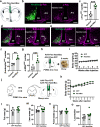The melanocortin action is biased toward protection from weight loss in mice
- PMID: 37069175
- PMCID: PMC10110624
- DOI: 10.1038/s41467-023-37912-z
The melanocortin action is biased toward protection from weight loss in mice
Abstract
The melanocortin action is well perceived for its ability to regulate body weight bidirectionally with its gain of function reducing body weight and loss of function promoting obesity. However, this notion cannot explain the difficulty in identifying effective therapeutics toward treating general obesity via activation of the melanocortin action. Here, we provide evidence that altered melanocortin action is only able to cause one-directional obesity development. We demonstrate that chronic inhibition of arcuate neurons expressing proopiomelanocortin (POMC) or paraventricular hypothalamic neurons expressing melanocortin receptor 4 (MC4R) causes massive obesity. However, chronic activation of these neuronal populations failed to reduce body weight. Furthermore, gain of function of the melanocortin action through overexpression of MC4R, POMC or its derived peptides had little effect on obesity prevention or reversal. These results reveal a bias of the melanocortin action towards protection of weight loss and provide a neural basis behind the well-known, but mechanistically ill-defined, predisposition to obesity development.
© 2023. The Author(s).
Conflict of interest statement
The authors declare no competing interests.
Figures







Similar articles
-
The central melanocortin system as a treatment target for obesity and diabetes: A brief overview.Eur J Pharmacol. 2022 Jun 5;924:174956. doi: 10.1016/j.ejphar.2022.174956. Epub 2022 Apr 14. Eur J Pharmacol. 2022. PMID: 35430211 Review.
-
A comparative study of the central effects of specific proopiomelancortin (POMC)-derived melanocortin peptides on food intake and body weight in pomc null mice.Endocrinology. 2006 Dec;147(12):5940-7. doi: 10.1210/en.2006-0866. Epub 2006 Sep 7. Endocrinology. 2006. PMID: 16959830 Free PMC article.
-
Pro-opiomelanocortin (POMC) deficiency and peripheral melanocortins in obesity.Nutr Rev. 2000 Jun;58(6):177-80. doi: 10.1111/j.1753-4887.2000.tb01857.x. Nutr Rev. 2000. PMID: 10885325 Review.
-
Mitochondrial uncoupling in the melanocortin system differentially regulates NPY and POMC neurons to promote weight-loss.Mol Metab. 2017 Oct;6(10):1103-1112. doi: 10.1016/j.molmet.2017.07.002. Epub 2017 Jul 8. Mol Metab. 2017. PMID: 29031712 Free PMC article.
-
Cyclin-dependent kinase 4/6 inhibitors require an arcuate-to-paraventricular hypothalamus melanocortin circuit to treat diet-induced obesity.Am J Physiol Endocrinol Metab. 2021 Mar 1;320(3):E467-E474. doi: 10.1152/ajpendo.00386.2020. Epub 2020 Dec 28. Am J Physiol Endocrinol Metab. 2021. PMID: 33356996 Free PMC article.
Cited by
-
An insight into carcinogenic activity and molecular mechanisms of Bis(2-ethylhexyl) phthalate.Front Toxicol. 2024 Jul 23;6:1389160. doi: 10.3389/ftox.2024.1389160. eCollection 2024. Front Toxicol. 2024. PMID: 39109301 Free PMC article.
-
An excitatory projection from the basal forebrain to the ventral tegmental area that underlies anorexia-like phenotypes.Neuron. 2024 Feb 7;112(3):458-472.e6. doi: 10.1016/j.neuron.2023.11.001. Epub 2023 Dec 5. Neuron. 2024. PMID: 38056455 Free PMC article.
-
Advanced neurobiological tools to interrogate metabolism.Nat Rev Endocrinol. 2023 Nov;19(11):639-654. doi: 10.1038/s41574-023-00885-6. Epub 2023 Sep 6. Nat Rev Endocrinol. 2023. PMID: 37674015 Review.
-
Runs of Homozygosity Detection and Selection Signature Analysis for Local Goat Breeds in Yunnan, China.Genes (Basel). 2024 Feb 28;15(3):313. doi: 10.3390/genes15030313. Genes (Basel). 2024. PMID: 38540373 Free PMC article.
-
An alternative neural basis underlying leptin resistance.Cell Rep. 2025 Jul 22;44(7):115863. doi: 10.1016/j.celrep.2025.115863. Epub 2025 Jun 19. Cell Rep. 2025. PMID: 40540394 Free PMC article.
References
Publication types
MeSH terms
Substances
Grants and funding
LinkOut - more resources
Full Text Sources
Molecular Biology Databases
Miscellaneous

